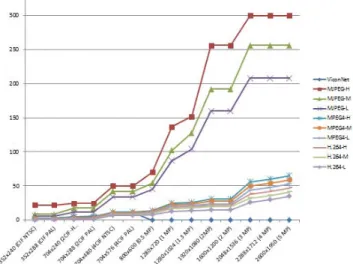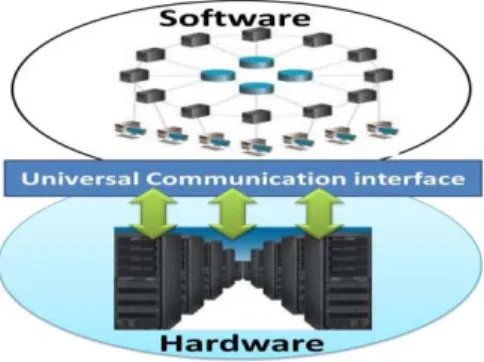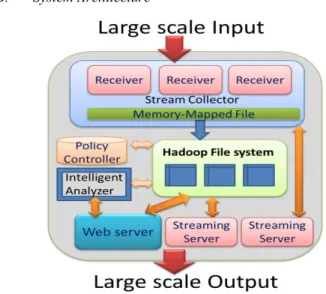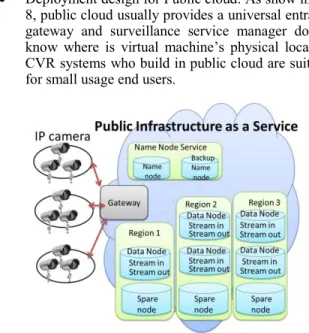A framework for scalable cloud video recorder system in surveillance environment
Chia-Feng Lin
Department of Computer Science, National Chiao Tung University, Hsinchu, Taiwan
teralin@gmail.com Muh-Chyi Leu
Industrial Technology Research Institute (ITRI), Hsinchu, Taiwan
mcleu@itri.org.tw
Shyan-Ming Yuan
Department of Computer Science, National Chiao Tung University, Hsinchu, Taiwansmyuan@gmail.com Ching-Tsorng Tsai Department of Computer Science, Tunghai University, Taichung Taiwan
cctasi@thu.edu.tw
Abstract— In recent years, video surveillance industry has encountered huge evolution. First, the IP based video cameras are gradually replacing the market share of Closed-circuit television (CCTV). Second, hardware and software based network video record come to market to support more amounts of camera sources. However, pure NVR hardware or software which is installed on single physical machine may reach maximum storage or throughput limitation due to predefined resource limitation. In this paper, we proposed a prototype of cloud based video recorder system under Infrastructure as a Service (IaaS) abstraction layer in cloud computing domain. This system provides scalable video recording, backup and monitoring features. Furthermore, this system was implemented using Hadoop distributed file system to store video streaming. In this way, Map / Reduce mechanism could be used to support intelligent video analysis tasks. The paper shares a good experience while design unlimited resource video recording system.
Keywords: Survillence Cloud , video recorder , Streaming I. INTRODUCTION
A. Evolution for IP based Video Survillance
In video surveillance industry, Internet protocol based cameras improve all-IP network based Surveillance environment. In order to fulfill good quality of video data transmission for network based surveillance environment, suitable audio and video compression algorithms are very important factors. For example, the codec, H.264 could even make over one hundred compression ratio for video data. In this codec, a 1080P (1920×1080) resolution video with 30 frame rate which have 750Mbit/s data size can reduce to 8Mbit/s or 4Mbit/s in Internet environment. It solves the main bottleneck of IP cameras, which is bandwidth limitation and storage consumption. Fig.1 shows a graph of compression factor between MJPG, MPEG4 and H.264 codec in different resolution. In this figure, H.264-H reduces almost seven times frame size then MJPEG-H and 20% then MPEG4 format. As time goes by, the improvement of
compression ratio makes all-IP based video surveillance much easier to achieve.
Figure 1. Compression factor between different resolution and codec
B. Trend from DVR to NVR
Nowadays, when surveillance industry changes to all IP network age, network video recorder (NVR), as a main component for surveillance environment, gradually replace exist digital video recorder (DVR). Key reasons are listed as follows :
x Compare to working environments: The main feature for NVR would focus on the networking capability. IP cameras can transmit streaming video to NVR for recording, manage and forwarding video frames. It supports more flexible deployment that reduce the limitation of physical location. Besides, because traditional DVR uses analog signal for connection. This kinds of connection signal may decrease as the distance becomes longer. In this way, deployment scope of DVR will be limited to small region. However, network based recording environment support longer distance due to the 2012 9th International Conference on Ubiquitous Intelligence and Computing and 9th International Conference on Autonomic
digital signal transition. Although signal attenuation also may occurs, digital signals is easier to duplicate over hubs, switches and routers.
x Comparison for Storage: DVR wait for analog signal to receive passively. Whenever front end camera device, cable or DVR device encounter to some errors, signal will miss and can’t store video to DVR. In other hand, NVR devices receive digital signal from IP camera to NVR, and then transmit monitoring channel from NVR to central manager system. Video data can store in many routing points. If some of the routing points fail, it’s much easier to replace or change to another service components. x Manage and maintenance: Internet connected NVR
have many advantages then DVR. For device monitoring and managing, NVR provides quite completeness information and remote control capability.
x Hybrid DVR/NVR: Traditional surveillance had already construct analog cable for decades. When they want to transform to network based surveillance environment, it’s costs much money to replace exist cable routing in a building or road. One possible solution is to deploy hybrid DVR/NVR devices. This means receives analogy signal from cable and digital signal from IP camera at the same time. And this device provides remote monitoring functionality. Fig 2 shows this kinds of example from NUUO’s[1] DVR/NVR architecture.
Figure 2. DVR/NVR with Internet connection.[1]
C. Trend From NVR to CVR
In city scope surveillance environment, total amounts of cameras may exceed one thousand devices. Sometimes, build more than ten thousands of cameras is possible. Most deployment architecture for large scale video recording solution are fix connection model. For example , each NVR responsible for 64 camera sources, and ten NVR can support 640 camera sources. Fig 3 is an example of this concept. This model is easy to deploy a large scale video recording environment. However, fix deploy model may waste resource while doesn’t allocating and reallocating cameras properly. For example, to support 100 camera source, two 64
route hardware NVR device are needed. But 24 route resource may be wasted. Besides, if individual NVR crash, real-time handoff is needed. As a result, it is important to design a video recorder system to support intelligent resource allocation and reallocation video recorder system.
Figure 3. Fix connection NVR environment
II. RELATED WORKS
A. Cloud computing and Virtualization
Cloud computing is a hot topic in recent years. It includes three levels of abstraction, which are Infrastructure as a Service ( IaaS), Platform as a service ( PaaS ) and Software as a Service ( SaaS ). Besides, there are many open source software such Hadoop, Cassandra and Mongo DB which is proposed under IaaS level. It provides a convenient way to build cloud services. Furthermore, operating system level virtualization technology such as VMware [9] and Xen [10] hypervisors bring a new concept to separate hardware and software. As Fig. 4 shows, in the cloud computing era, hardware and software are connected by a universal communicate interface, software service do not need to deal with too many physical compatible problems. In this way, many scalable cloud service and application come to market, such as cloud storage services, distributed database with NO-SQL concepts, Map-Reduce for large scale analysis… etc.
Figure 4. Conceptual model for Hardward and Software in cloud computing ege.
B. Video Survillance
Some surveillance users are turning to software for automated video surveillance [2]. Some researcher focus on design a surveillance middleware architecture [3]. They use a graph to structure their middleware and a distributed blackboard architecture based on service-oriented architecture (SOA) to process all computational tasks of their system. Besides it is important to build an automated and modular distributed real-time video surveillance system[4][11][12]. In real case, [5] build a central cluster for large wide area, large scale camera network in campus under Hadoop distributed file system. But this study main discuss how to build a useful test datasets, not building a scalable architecture.
C. Existing Video Recording systems
Currently, high level hardware based network based video recorder device may support 64 channels of concurrent streaming source. It’s hard to keep on increasing connected channels on single device due to hardware limitation and economic consideration. In the meanwhile, there are some software based network video recorder products come to market. Such as Geovision’s IP surveillance software [6] and NUUO’s Central Management System[7] . They supports at most 200 channels for recording in single physical machine. However, the maximum number of channels from individual software NVR instance is also fixed. A central management system would monitor all status from every NVR system. But if some NVR instance is crashed, current CMS lack the ability to dynamic recovering recording streaming connections. Besides, NVR channels may waste without manual setups. The interactive between CMS and NVR should be redefine to support more flexible resource management.
III. METHOD
A. Scenerio for Cloud Video Recorder System
In this research, we design a scalable, flexible and reliable cloud based video recording system (CVR system), Fig. 5 shows the scenario of proposed system. This solution is design in Infrastructure as a Service abstraction layer in cloud computing that manages platform by CVR service provider. This system was divided into three abstraction portions according to its working stage, they are Device portion, Cloud portion and User portion. For the Device portion, any kind of video data could be uploaded to CVR by real-time / offline upload using streaming, FTP, Mail or other network data transfer protocols. The source stream may come from DVRs with networking capability, network video recorders (NVR), IP Cameras, Digital Cameras with Wi-Fi capability, mobile device and vehicle DVRs installed on cars. In video surveillance industry, most of the video sources come from fix location IP cameras on the road, buildings or any interesting spots. A total amount of IP cameras may exceed one thousand or even ten thousand sets in a city scale environment. It is hard to optimize all resources from
hundreds of IP cameras without scalable recording architecture. Therefore, we propose the CVR system to fulfill this demand in the Cloud portion, more detailed design is shown in the following sections. Besides, remote user monitoring function in User portion is an impartment feature for a video recording system. But how to provide a scalable framework and minimize resource consumption is also a practical issue.
Figure 5. A scenerio for proposed cloud video recorder.
B. System Architecture
Figure 6. Functional architecture for cloud video recorder Fig. 6 is the functional architecture of proposed cloud video recorder ( CVR ) system. In this study, we integrate several cloud computing concept to design components of CVR system which are listed below:
x Virtuallization : Fig. 7 shows an resource allocation example on hypervisor to building CVR system. To design a scalable architeccture, each component is modulized and allocated dynamically based on real usage under Internet-connected distributed system.
x Stream Collector: To support large scale stream collecting service, a coordinator, Stream Collector is used to dispatch real-time loading dynamiclly while processing input stream.
x Streaming Server: The streaming servers are install in each running virtuall machine that share computation and network I/O loading on distributed node. For real-time video monitoring function, in order to reduce disk I/O overhead while output stream to users. memory-mapped file (mmap) technology is taken to store temporary video data. An open source software FFmpeg is also integrated here to support realtime video format and resolution transcoding.
x Hadoop File System: Hadoop file system is applied in our CVR system to support distributed software backup mechanism. After Stream Collector service that run on specific cloud instance receive video stream, Hadoop-Fuse protocol is used to store video data into Hadoop filesystem.
x Policy controller: This components is used for access control and processing operation logs. This deaman would communicate with distributed database, HBase to overcome scalability limitation.
x Intelligent Analysis: Due to video data is store in Hadoop’s file system, Hadoop Map-Reduce function can be applied for intelligent video analysis. This is a important module but not support on current stage of our CVR system. After CVR is well implement, we will add this feature.
x Web server: This component provides a content manage system ( CMS ) for user and retrieve video data from stream out service. But stream out service is isolated to this component to enlarge service capability.
Figure 7. Porposed cloud video recorder system inside individual virtual machine in the cloud.
C. Deployment Design
Cloud based video recording environment is a kind of bandwidth sensitive application. It needs a lot of bandwidth
to support huge amount of video sources. According to this issue, nearby private cloud would save network traffic than public cloud service. But public cloud is more convenient than private to build a CVR service without hardware investment. We propose two kind of deploy design, the first one build in public cloud and the second one build in private cloud.
x Deployment design for Public cloud: As show in Fig. 8, public cloud usually provides a universal entrance gateway and surveillance service manager do not know where is virtual machine’s physical location. CVR systems who build in public cloud are suitable for small usage end users.
Figure 8. Stream service for cloud video recorder under public cloud. x Deployment design for Private/hybrid cloud: As
show in Fig. 9, there are two major portions in our CVR system. They are central directory and nearby storage & processing node. The central directory provides coordinating tack for overall CVR system includes Name node cluster, video analytics functionality and policy control. The nearby storage & processing node receive streaming from recording device, store data locally and provide remote monitoring feature. g
IV. EXPERIMENT DESIGN & DISCUSSION
In this section, some design experience are shared to those who want to design a cloud based video recorder system.
A. Experiment setup
The experiment environment use VMware Exsi 5.0 as the hypervisor and deploy on three Intel i5 level physical machines with 8G memory. The operating system uses Ubuntu 10.04, Hadoop 0.20. Also, open source software, Live555 is the simulated to be client side streaming source. Besides, Hadoop-Fuse is also used to support
video storing.
B. Bandwidth usage
When we talk about cloud based or network based video recording system, bandwidth and storage is very sensitive due to the heavy load network resources usage. Table 1 show that different content type and encoding protocol brings different bandwidth consumption. In highly variant activity such as in casino, H.264-M format may generate 1.2 ratio frame size. But the frame size ratio which is 0.65 while in Medium Low office. In this case, how to simulate network environment becomes difficult to predict.
Table 1. Frame size between different encoding formats [8]
In addition, Table 2 shows the estimated storage usage between different parameters. Each camera may generate 1450 Kbps network traffic and almost 24 gigabytes video data from 1Mega IP camera. In this way, if someone wants to deploy one thousand IP cameras during a week, it needs 168TB disk space and 1450Mbps bandwidth consumption. When IP camera’s resolution changes to Full HD, it may needs at least 6 Mbps network bandwidth under H.264-medium quality codec. It is really bandwidth sensitive while
deploy large scale video recording environment. Table 2 Estimate storage usage in different parameters
C. Backup issue
This system proposes software backup feature, which was based on Hadoop replica mechanism. The placement of replica is illustrated in Fig. 10. In this figure, second replica is place on nearby data node, and third replica is place on different location to provide failover mechanism.
Figure 10. Backup scenerio for cloud video recorder within Hadoop file system.
D. Video Analysis using Map Reduce technology
x The functionality of CVR for Intelligent analysis includes real-time analysis and offline analysis. For real-time analysis case, pattern recognition task can be made by either entry instance or backup instance. It is possible to tracking a moving object across different camera sources by reporting status to name node periodically. Also, CPU intensive task such as face recognition can be shift to different instance. Furthermore, since video data is stored in Hadoop file system, large scale analysis technology Map-Reduce can be applied at this time. Fig.11 shows an example while using Map-Reduce analysis technology.
Figure 11 An example for using Map Reduce technology for Hadoop in cloud video recorder system.
E. User monitoring
In the cloud computing age, access content from web protocol is quite essential functionality because users don’t need to install additional standalone software. However, there are still some issues need to address:
z Real time Transcending: Due to client side video format support issue and display resolution is limited by bandwidth. The CVR system’s value would increase if it can transcode video sources to
suitable formats and resolution for user. Currently, we use open source software, FFmpeg to transcending video resolution and format dynamically. However, this software is CPU intensive application, if more and more people access video from the same server, it will produce a system bottleneck. We plan to use different copy on different server to support the variance of user request.
z Streaming technology: Currently, most IP camera provide remote browsing use OCX in Microsoft Internet Explorer (IE ) browser. Main advantage for OCX is the client side decoding function. But these application is IE only, which means can’t access in chrome, Firefox or safari at personal computer. Furthermore, users who only have mobile device can’t use this function. How to find good cross browser streaming technology is worth to invest. It’s possible to apply HTML5 standard to solve this problem. But current HTML5 doesn’t support enough standard tags to support the variance of streaming operation. We hope that future version of HTML5 may cover this issue.
V. CONCLUSION AND FUTURE WORKS
In this paper, we propose a framework of cloud based video recording system. This framework integrates a distributed file system to achieve a scalable, reliable and virtualized architecture. In implementation design Hadoop HDFS and HBase are integrated together to reach scalability demand. In the near future, we still plan to do some tasks:
x More experiments in proposed system, such as deploy one thousand real time source and observe it’s outcome.
x Intelligent and Real-time Motion detection: apply Map/Reduce framework to make real time patent recognition using replica data on backup node.
ACKNOWLEDGMENT
This study was supported by the National Science Council, Taiwan, under grant No. NSC99 -2511 -S - 009 - 012 - MY3 and Industrial Technology Research Institute (ITRI)
REFERENCES
[1] Nntwork deployment chart from NUUO CMS illustration http://gsf.com.my/dvr/NUUO/NUUOcms.htm, retrieved 2012.06 [2] M. Valera Espina, S.A. Velastin, “Intelligent Distributed Surveillance
Systems: A Review",” IEE Proc. Vision, Image and Signal Processing, Apr. 2005, pp. 192–204.
[3] Henry Detmold, Anton van den Hengel, Anthony Dick, Katrina Falkner, and David S. Munro, “Middleware for Distributed Video Surveillance,” IEEE Distributed Systems Online, vol. 9, no. 2, 2008,pp. 1-10.
[4] Drew Ostheimer, Sebastien Lemay, Mohammed Ghazal, Dennis Mayisela, Aishy Amer, and Pierre F. Dagba,, “A modular distributed video surveillance system over IP,” 2006 Canadian Conference on Electrical and Computer Engineering, CCECE'06, May 7-10 2006, pp. 518-521.
[5] Thomas Kuo, Zefeng Ni, Carter De Leo, and B.S. Manjunath, Design and Implementation of a Wide Area, Large-Scale Camera Network, IEEE Computer Society Conference on Computer Vision and Pattern Recognition, IEEE Workshop on Camera Networks, Jun. 2010
[6] Geovision GV-NVR IP Surveillance Software
http://www.a1securitycameras.com/Geovision-GV-NVR-32-3rd-Party-Geovision-NVR-IP-Video-Surveillance-System-32-ch.html, retrieved 2012.06
[7] The Illustration for NUUO Central Management System http://www.nuuo.com/product.php?id=17, retrieved 2012.06
[8] Vicon Camera Calculator, http://www.vicon-security.com retrieved 2012.06
[9] P Li, Selecting and using virtualization solutions: our experiences with VMware and VirtualBox, Journal of Computing Sciences in Colleges, 25 (3), 2010 , pp. 11-17
[10] P Barham, B Dragovic, K Fraser et al, Xen and the art of virtualization, SOSP '03 Proceedings of the nineteenth ACM symposium on Operating systems principles, 2003, pp 164-177 [11] Wu Chao and Xin Ming Jun, "Multi-agent based distributed video
surveillance system over IP", IEEE Computer Science and Computational, in Proc. of ISCSCT '08, 2008 pp.97-100
[12] H. Detmold, A. van den Hengel, A. Dick, A.Cichowski, R. Hill, E. Kocadag, K. Falkner, and D.S. Munro, "Topology Estimation for Thousand-Camera Surveillance Networks", IEEE Distributed Smart Cameras (ICDSC), 2007 , pp. 195-202




![Table 1. Frame size between different encoding formats [8]](https://thumb-ap.123doks.com/thumbv2/9libinfo/7631074.135098/5.918.553.779.224.345/table-frame-size-different-encoding-formats.webp)